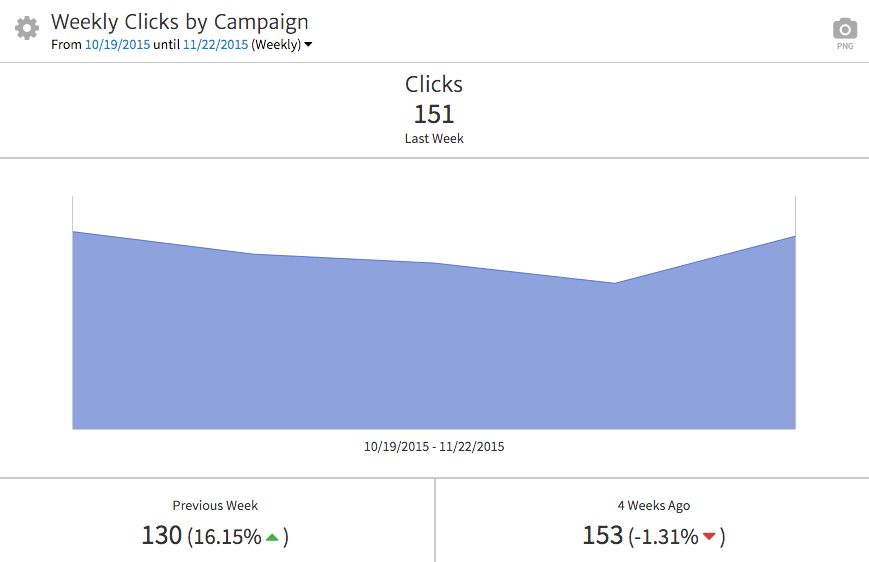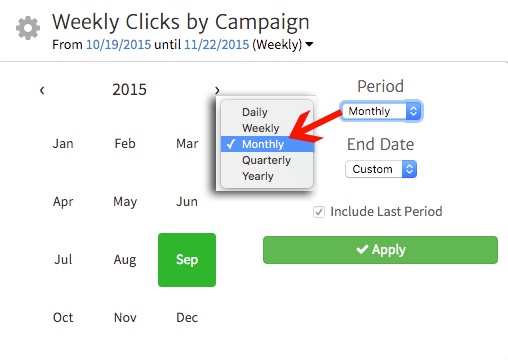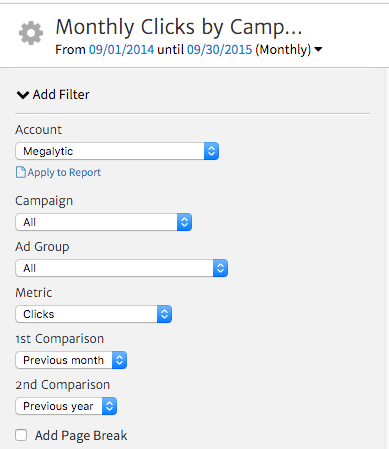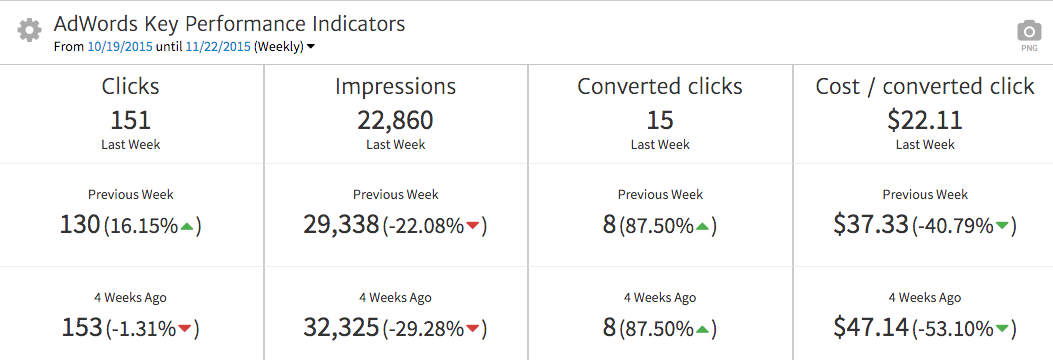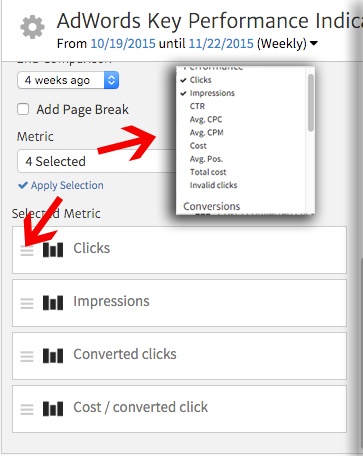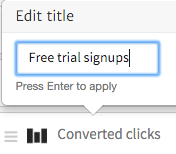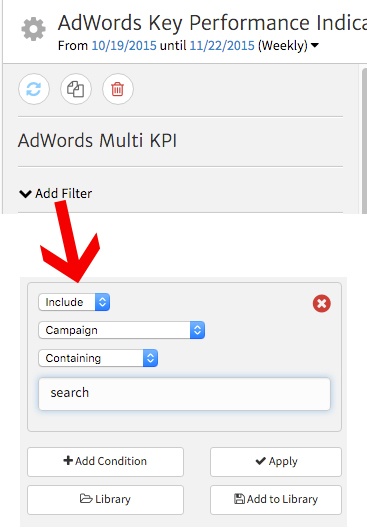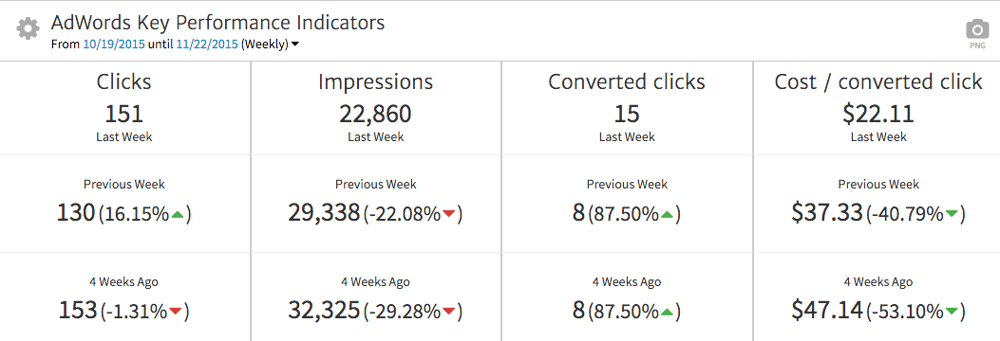
Using the Single KPI Widget
When you add the single AdWords KPI widget to your report, you’ll be asked to select an AdWords account to link. Once chosen, you’ll immediately see data from the past seven days, compared to the previous week and the same period four weeks ago.
Comparing data to past periods is crucial to reporting long term success for digital marketing campaigns.
Next, you can customize the widget to show a different date range via the date dropdown. You can choose from five different period types:
- Daily
- Monthly
- Quarterly
- Yearly
Weekly
After selecting period type, you can then select the specific date range you’d like to show. Apply your edits to the report, and you’ll see it update based on your changes. In this case, we’ve chosen to show data by month, so the widget now shows data from our selected month, compared to the previous month and the same period in the previous year.
To further customize the widget, select the gear symbol in the upper left. You’ll now see several options to tweak it to show the information that matters most for your report.
Perhaps you’d like to show data tied to a different AdWords account linked to your Megalytic account. To do so, select it from the “Account” dropdown and click “Apply to Report.”
Next, you can choose to show data from a specific campaign or ad group using the respective dropdowns. For instance, you may want to show performance from a select sales region that has its own campaign in AdWords. Or you may want to show data from a specific ad group representing a category of products your client sells.
You can also choose a different metric for the widget from the Metric dropdown. Depending on what you want to report, you can choose from among the following:
- Clicks
- Impressions
- CTR
- Avg. CPC
- CPM
- Cost
- Avg. Position
- Total cost
- Invalid clicks
- Converted clicks
- Cost/converted click
- Click conversion rate
- Cost/estimated total conversion
- Est. total conversion rate
- Conversions
- Est. total conversions
- Cost/conversion
Finally, you can choose to show one or two comparisons using the dropdowns at the bottom. For instance, if your AdWords account has only been active for a couple of months and you don’t have data from the past year, you’ll want to compare only with the previous month.
Show More Data with the Multi KPI Widget
If you want to show more than just one metric, you can, of course line up multiple KPI widgets together in the report. However, these will quickly start to take up significant space.
As an even better option, use the AdWords Multi KPI widget, which can show up to four metrics at a time. This widget offers a concise way to show how multiple statistics have increased or decreased over time. In addition, it helps to encourage clients to look at multiple metrics together. For example, a client may see a decrease in impressions as a negative sign, but may then note that conversions have increased, since both are highlighted in the widget.
You can customize this widget much in the same way as the single AdWords KPI widget. However, as the name of the widget suggests, you can choose multiple metrics from a dropdown and then rearrange them in whatever order you’d like. Click and drag the “hamburger” icon (stack of three lines) to the left of any widget to change its position.
You can also rename any metrics to clarify them for your clients, making them easier to understand. For instance, if “converted clicks” equates to a free trial signup for your campaign, you may want to rename the metric to be more descriptive to the client. Click any metric in the list to trigger a text box, where you can then enter a new name.
Filtering Data
You may want to filter the data beyond the Campaign and Ad Group options available by default. To do so, you can use Megalytic’s built-in filtering options, available for most widgets.
For instance, you may want to show data for multiple campaigns, while the default “Campaign” dropdown only lets you select one campaign. To set up a filter, click “Add Filter” from the top of the widget options. Next, enter your desired parameters.
In this case, we want to show data only from search campaigns, which all have names that include the word “search.” We’ll set up our filter to include any campaign containing the word “search” (entering that word in the text box). Finally, we’ll click “Apply” to update the widget.
You can also filter by any of the various AdWords metrics available for the widget. For instance, you can choose to include data only from campaigns with clicks greater than a threshold you set, to exclude low volume campaigns from the report. You could also choose to report specifically on the campaigns that drove conversions, or those that didn’t.
Mix and Match Multiple Widgets
You don’t have to limit yourself to just one AdWords KPI widget in your report; you can add multiple ones in to show additional data. For instance, you may want to show quarterly data every three months, in addition to showing monthly data.
You can also create separate widgets for different categories of data. For instance, one could show conversion-specific data (Conversions, Conversion Rate, and Cost/Conversion) while another could show traffic-related data (Clicks, Impressions, CPC, and CTR). You could also summarize cost-specific stats such as CPC, Cost/Conversion, and total campaign Cost.
Conclusion
Megalytic’s AdWords KPI widgets provide a user-friendly way to highlight snapshots of online advertising performance in your digital marketing reports to make reports scannable and actionable for busy executives. Summarize your main campaign metrics with these widgets at the top of your report.
By highlighting key performance indicators to clients, you’re ultimately proving the value of your AdWords work to the executives who may only give a quick glance at a report, or who might not understand the nitty-gritty details. Be sure that you’re showing the big picture in reports, in addition to breaking down the specific details of performance.
